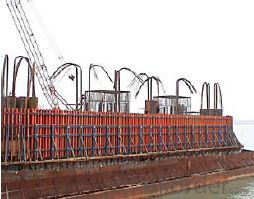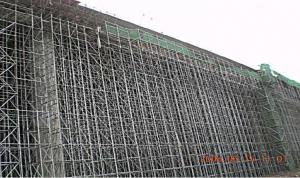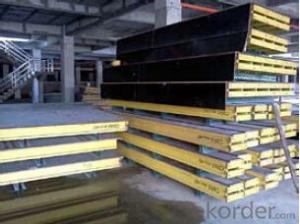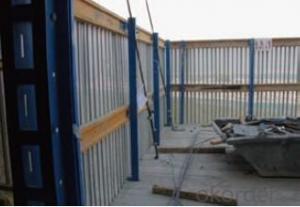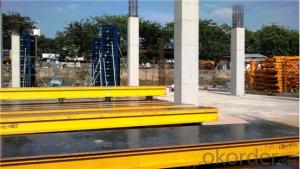Single-side Climbing Bracket SCB-180 for formwork and scaffolding system
- Loading Port:
- Tianjin
- Payment Terms:
- TT OR LC
- Min Order Qty:
- 50 m²
- Supply Capability:
- 1000 m²/month
OKorder Service Pledge
OKorder Financial Service
You Might Also Like
Single-side Climbing Bracket SCB180:
With CNBM SCB 180 climbing systems, the loads from the fresh concrete pressure are transferred through the brackets by means of V-strongbacks and compression braces into the scaffold anchors.
Typical applications for the SCB 180 are dams, locks, cooling towers, pier heads, tunnels, and bank vaults.
The formwork is simply tilted backwards when striking takes place. The 1.80 m wide bracket requires only a minimum of space.
Characteristics:
◆ Economical and safe anchoring
The M30/D20 climbing cones have been designed especially for single-sided concreting using
SCB180 in dam construction, and to allow the transfer of high tensile and shear forces into the still
fresh, unreinforced concrete. Without wall-through tie-rods, finished concrete is perfect.
◆ Stable and cost-effective for high loads
generous bracket spacings allow large-area formwork units with optimal utilization of the bearing
capacity. This leads to extremely economical solutions.
◆ Simple and flexible planning
With SCB180 single-sided climbing formwork, circular structures can also be concreted without
undergoing any large planning process. Even use on inclined walls is feasible without any special
measures because additional concrete loads or lifting forces can be safely transferred into the
structure.
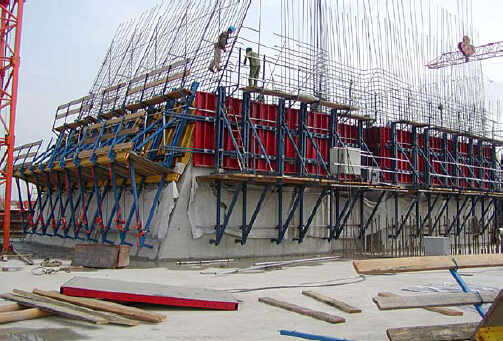
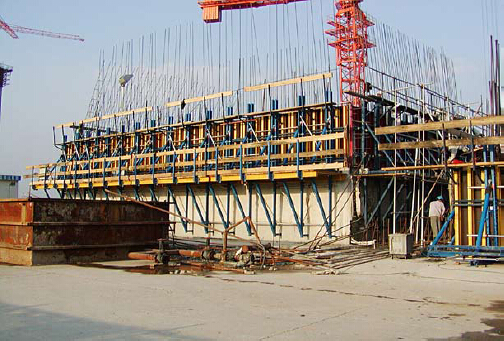
- Q: How does steel formwork contribute to sustainable construction?
- Steel formwork contributes to sustainable construction in several ways: 1. Durability: Steel formwork is highly durable and can be reused multiple times, reducing the need for frequent replacements. This reduces the consumption of materials and decreases waste generation, making it an environmentally friendly choice. 2. Energy Efficiency: Steel formwork requires less energy for manufacturing compared to other materials like wood or plastic. This results in lower carbon emissions during the production process, contributing to reduced greenhouse gas emissions. 3. Waste Reduction: The use of steel formwork minimizes construction waste. Unlike traditional formwork materials that are often discarded after a single use, steel formwork can be easily dismantled, cleaned, and reused for future projects. This reduces the amount of waste sent to landfills and promotes a circular economy. 4. Increased Construction Speed: Steel formwork is known for its speed and efficiency in construction projects. Its modular design allows for quick assembly and disassembly, reducing construction time and energy consumption. This, in turn, minimizes the disturbance to the surrounding environment and reduces the overall carbon footprint of the project. 5. Improved Safety: Steel formwork provides a stable and secure platform for workers during the construction process. Its strength and rigidity reduce the risk of accidents and injuries, ensuring a safer working environment for construction workers. This leads to lower healthcare costs and increased worker productivity. Overall, the use of steel formwork in construction promotes sustainability by reducing waste, energy consumption, and carbon emissions. Its durability, reusability, and efficiency make it a valuable option for sustainable construction practices.
- Q: Is steel formwork easy to assemble and disassemble?
- Compared to other formwork systems, steel formwork offers a relatively simple assembly and disassembly process. By utilizing prefabricated panels, steel formwork can be easily connected and secured through various methods like clamps, pins, or wedges. These lightweight panels are also available in standardized sizes, ensuring convenient handling and transportation. Furthermore, steel formwork provides the advantage of adjustability and reusability. Adjustable screws or other mechanisms enable easy adaptation to different dimensions and shapes, granting flexibility in construction projects. Additionally, steel formwork can be utilized multiple times, significantly reducing the time and cost required for subsequent formwork installations. The disassembly process for steel formwork is also straightforward. Once the concrete has fully cured, the panels can be effortlessly removed by releasing the connecting mechanisms and dismantling the formwork system. Due to the lightweight nature of steel formwork panels, handling and removal are less labor-intensive compared to heavier materials like timber or plywood. In summary, the simplicity of assembly and disassembly makes steel formwork a highly favored choice for construction projects, particularly those that necessitate repetitive use and quick turnaround times.
- Q: All I know is that prices are different
- At the same time, the steel formwork concrete formwork, the concrete surface is smooth and beautiful, is a good way to die in the process of transport is not easy deformation.
- Q: Can steel formwork be used for both residential and industrial construction projects?
- Yes, steel formwork can be used for both residential and industrial construction projects. Steel formwork is a versatile and durable solution that can withstand the demands of various construction projects. It offers a high level of strength and stability, making it suitable for both small-scale residential projects and large-scale industrial projects. Additionally, steel formwork has the advantage of being reusable, which can help save costs and reduce waste in construction projects. It can be easily assembled and disassembled, making it a practical choice for different types of projects. Overall, steel formwork is a reliable and efficient option for both residential and industrial construction projects.
- Q: What are the considerations when designing steel formwork for slabs with openings?
- When designing steel formwork for slabs with openings, several key considerations need to be taken into account. These include the size and location of the openings, the required load-bearing capacity of the formwork, the method of supporting the formwork, and the ease of installation and removal. Additionally, factors such as safety, durability, and cost-effectiveness should also be considered during the design process.
- Q: Can steel formwork be easily repaired in case of damage?
- Yes, steel formwork can be easily repaired in case of damage. Steel is a durable and malleable material, allowing for straightforward repairs such as welding, patching, or replacing damaged sections. Additionally, its strength and resilience make it less prone to damage compared to other formwork materials like wood or plastic.
- Q: What are the considerations when designing steel formwork for dams?
- When designing steel formwork for dams, several considerations need to be taken into account. Firstly, the formwork needs to be strong and durable enough to withstand the heavy loads and pressures exerted by the concrete during pouring and curing. It should be able to resist any deformations or distortions that may occur due to these forces. Secondly, the formwork should be designed to provide a smooth and even finish to the concrete surface. This is crucial as it affects the structural integrity and aesthetics of the dam. Care should be taken to avoid any gaps or unevenness in the formwork that could result in defects or weak points in the concrete. Thirdly, the design of the formwork should allow for easy and efficient installation and removal. The formwork needs to be modular and adjustable so that it can be easily assembled and disassembled, allowing for flexibility in the construction process. Additionally, considerations should be made for proper access and safety measures for workers during the formwork installation and removal stages. Lastly, the formwork design should also take into account any specific requirements or constraints of the dam construction project, such as the shape and dimensions of the dam, the presence of any special features or structures, and any environmental or logistical considerations. Overall, designing steel formwork for dams requires careful consideration of strength, smoothness, ease of installation, and adherence to project-specific requirements.
- Q: How does steel formwork contribute to the overall accuracy of concrete placement?
- Steel formwork contributes to the overall accuracy of concrete placement by providing a sturdy and rigid structure that ensures precise and consistent dimensions of the concrete elements. It helps in maintaining the desired shape, level, and alignment of the concrete, resulting in a uniform and smooth finish. The strength and stability of steel formwork prevent any deformation or movement during the pouring and curing process, which is crucial for achieving accurate and reliable concrete placement.
- Q: How does steel formwork affect the overall construction timeline?
- Steel formwork can significantly affect the overall construction timeline in several ways. Firstly, steel formwork is known for its durability and strength, allowing for faster and more efficient construction processes. Unlike traditional timber formwork, steel formwork can be reused multiple times, reducing the time and effort required for dismantling and reassembly. This reusability not only saves time but also minimizes the need for additional materials, thereby reducing construction waste and costs. Additionally, steel formwork provides greater flexibility in terms of design and customization. Its versatility allows for complex shapes and structures to be easily created, reducing the need for extensive modifications or adjustments during the construction process. This flexibility not only saves time but also enhances the overall construction efficiency. Moreover, steel formwork offers quicker curing times for concrete, as it provides better temperature and moisture control. This accelerates the process of concrete setting and reduces the time required for form removal. Consequently, the construction timeline is shortened, enabling subsequent construction activities to commence earlier. Furthermore, steel formwork is known for its high load-bearing capacity, enabling multiple floors to be constructed simultaneously. This parallel construction approach can significantly expedite the construction process, thereby reducing the overall timeline. However, it is important to note that while steel formwork offers numerous advantages, its initial setup and installation may require more time compared to other formwork materials. The steel formwork system needs to be properly aligned and secured, which might take longer than setting up traditional timber formwork. However, this initial time investment is often offset by the time saved during subsequent construction stages. In conclusion, steel formwork can have a positive impact on the overall construction timeline. Its durability, reusability, versatility, quicker curing times, and high load-bearing capacity contribute to faster construction processes, reduced material waste, and increased construction efficiency. Despite the initial setup time, the benefits of steel formwork ultimately result in a more streamlined and accelerated construction timeline.
- Q: How is steel formwork adjusted for different concrete thicknesses?
- Steel formwork can be adjusted for different concrete thicknesses by using adjustable formwork systems. These systems typically include adjustable props, beams, and panels that can be configured and secured to accommodate varying concrete depths. The props can be extended or shortened to provide the necessary height, while the beams and panels can be adjusted and connected to ensure a tight fit around the concrete structure. This flexibility allows the steel formwork to be easily adapted to different concrete thicknesses during construction.
Send your message to us
Single-side Climbing Bracket SCB-180 for formwork and scaffolding system
- Loading Port:
- Tianjin
- Payment Terms:
- TT OR LC
- Min Order Qty:
- 50 m²
- Supply Capability:
- 1000 m²/month
OKorder Service Pledge
OKorder Financial Service
Similar products
Hot products
Hot Searches



